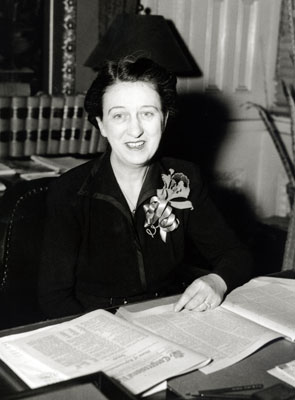Veronica Grace Boland
Representative, 1942–1943, Democrat from Pennsylvania
 Image Courtesy of the Martin Luther King, Jr., Memorial Library, Washington, D.C.
Image Courtesy of the Martin Luther King, Jr., Memorial Library, Washington, D.C.The first woman to serve in Congress from Pennsylvania, Veronica Grace Boland, only served for two months, completing the term of her late husband, Patrick J. Boland, the popular Democratic Whip, who had died just before winning a primary election. “I’ve always preferred the background,” Congresswoman Boland had told the press upon her election.1 But her victory served as a tribute to her husband. Postmaster General Frank C. Walker, a family friend, told the Scranton Tribune that her election “came as a deserved recognition of Mr. Boland’s long public service.”2
Veronica Grace Barrett was born in Scranton, Pennsylvania, on March 18, 1899, a daughter of Patrick and Winifred Barrett, immigrants from Ireland. She graduated from the Scranton Technical High School in 1918. She later married Patrick J. Boland, a carpenter and building contractor. They had two sons: Patrick, Jr., and Eugene. Patrick Boland went on to a political career, elected to Scranton’s city council and school board before serving as Lackawanna County commissioner from 1915 to 1919. In 1930 he was elected to a House seat as the nominee of the Republican, Democratic, and Labor parties. This left Boland free to choose which party caucus to join. He chose to organize with the Democratic Caucus, which held a narrow majority in the 72nd Congress (1931–1933). By his third term, Boland became Democratic Whip and was briefly a contender for Democratic Leader against Representative John McCormack of Massachusetts, the eventual winner, in 1940.3 Senator Joseph F. Guffey, the Democratic leader of Pennsylvania, made retention of Boland as Whip a condition before throwing the state’s House delegation behind Sam Rayburn of Texas in his run for House Speaker in 1937.4 Boland was credited with creating an effective Whip organization, and he was praised for his ability to determine how a vote would come out quickly and accurately. One of his triumphs was assisting Speaker Rayburn to extend the selective service system by one vote just months before the Pearl Harbor attack in 1941.5
On May 18, 1942, Patrick Boland died suddenly of a heart attack at home in Scranton, the morning before he won nomination in the Pennsylvania primaries for another House term. Majority Leader McCormack announced Boland’s death by suggesting that wartime demands had made Boland “a casualty of the present conflict.”6 His death came at a time when Pennsylvania politics were quite volatile. New Deal policies had made the Democrats competitive in this predominantly Republican state, and the Democrats were particularly concerned with avoiding any potential fractures in their ranks.7 The executive committee of the Pennsylvania Democratic Committee turned to Veronica Boland, Patrick’s wife, to fill his unexpired term on June 5, 1942. Running unopposed, she won November 3, during the first congressional elections held after American intervention in World War II. “I really can’t get excited about it,” Boland told a group of reporters upon her election as Pennsylvania’s first woman Representative. “I would rather have Mr. Boland there, of course.”8 She chose not to run for a full term to the 78th Congress (1943–1945), an election that was held the same day as her special election. At the same time, her willingness to serve out her husband’s term bought the party’s executive committee some time to settle upon a more experienced candidate for the next Congress.
Boland was sworn in and seated on November 19, 1942, less than a month before Congress adjourned on December 16.9 As a consequence, she received no committee assignments and made no floor speeches.
After retiring from Congress, Veronica Boland returned to Scranton and worked as an executive secretary for the Dutch Manufacturing Company until 1957. She retired when she underwent eye surgery.10 Boland died in Scranton on June 19, 1982.
Further Reading
“Boland, Veronica Grace” Biographical Directory of the U.S. Congress, 1774–Present, http://bioguide.congress.gov/scripts/biodisplay.pl?index=B0000602.
Footnotes
- Hope Chamberlin, A Minority of Members: Women in the U.S. Congress (New York: Praeger, 1976): 159.
- Chamberlin, A Minority of Members: 159.
- “Capital Leaders Mourn Boland,” 19 May 1942, Washington Post: 1.
- D.B. Hardeman and Donald C. Bacon, Rayburn: A Biography (Austin: Texas Monthly Press, 1987): 212; Joseph F. Guffey, Seventy Years on the Red-Fire Wagon: From Tilden to Truman, From New Freedom Through New Deal (n.p., 1952): 114. Rayburn lost the campaign but in September 1940, was elected Speaker after the death of William B. Bankhead of Alabama.
- “Capital Leaders Mourn Boland”; Hardeman and Bacon, Rayburn: 265.
- “Capital Leaders Mourn Boland.”
- Guffey, Seventy Years on the Red-Fire Wagon: 74–81; Philip S. Klein and Ari Hoogenboom, A History of Pennsylvania, second and enlarged edition (University Park: Pennsylvania State University Press, 1980): 465–470; David R. Contosta, “Reforming the Commonwealth, 1900–1950,” in Randall M. Miller and William Pencak, eds., Pennsylvania: A History of the Commonwealth (University Park: Pennsylvania State University Press, 2002): 300.
- Chamberlin, A Minority of Members: 159.
- “Mrs. Boland Begins Service in House,” 20 November 1942, Washington Post: B11.
- Chamberlin, A Minority of Members: 159.

